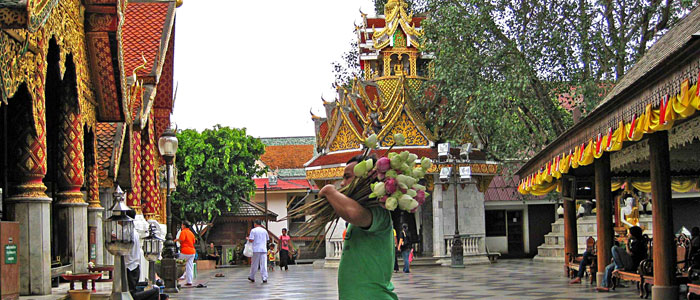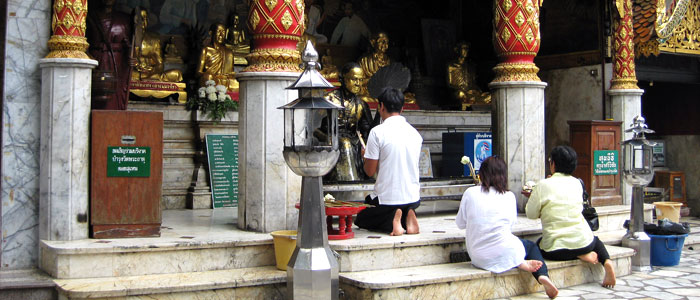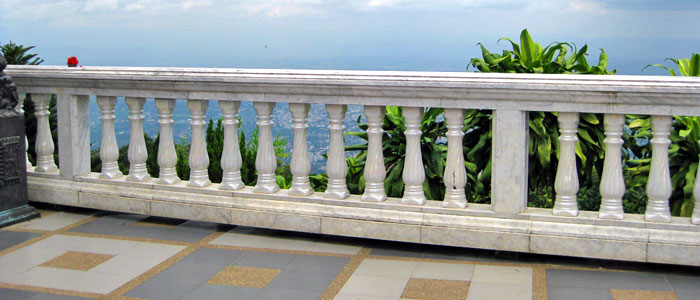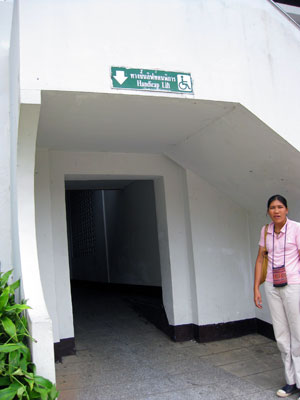Chiang Mai, Thailand Travel Guide
About Getting Around Attractions Hotels Eats Essentials & Practicals
Doi Suthep Temple

Wat Doi Suthep in Chiang Mai
Overview: The magnificent pinnacle, Wat Phra That Doi Suthep, of Thailand’s Buddhists temples rests on top of Doi Suthep, which means mountain. The temple itself is named after the mountain, Doi Suthep. Built in the 14th century under King Geu Na, Doi Suthep Temple, the most acclaimed and holy of Thai temples, is located roughly 15 kilometers west of Chiang Mai and is 1060 meters above the city (claimed by a tour guide).
Many aspects of Doi Suthep Temple stand out to the visitor (and the type of visitors can range from monks, anyone on a pilgrimage, tourists and locals). After you wind through and up the beautiful mountainside of Doi Suthep, you’ll find encounter a couple of sections at the base of the Doi Suthep Temple: the Naga Staircase and the ticket booth and cable car. The Naga Staircase has 306 steps for visitors to climb. Why so many steps? The staircase was built, much like the steep steps of Angkor Wat reaching up to the second and third tiers, to give visitors a chance to demonstrate their respect for Buddha. Climbing the 306 steps indicates how much respect you have for Buddha in other words. If you don’t want to or can’t climb the fitness steps, you can reach the main deck of Doi Suthep Temple via a cable car. The cable car is really an elevator with glass on tracks.

Wat Doi Suthep
On the Doi Suthep Temple deck or main ground, you’ll see a Sala tree. Make your way up the ramp and Doi Suthep surprises you with beautiful structures, including pavilions, sloped tiled roofs, a shrine and statues. At the center of Doi Suthep stands a gold-plated Chedi, which is a monument nearly 80 feet tall. Saunter right and circle around the temple deck. You’ll see small and large bells, some of which are double-stacked. You’ll also see a white elephant guarding a pagoda. Legend has it that the white elephant carried Buddha’s relic up Doi Suthep mountain and died. King Geu Na commissioned Doi Suthep Temple to be built on this holy sight.

Terrace at Wat Doi Suthep
A little further ahead, you’ll encounter Doi Suthep Temple’s terrace, from which you can see the city of Chiang Mai and the lush, forest of Doi Suthep mountain. This terrace is one of Doi Suthep Temple’s top draws for tourists and the curious. It is a place for meditation and spirituality for many.
Turn the bend and there’s a quaint snack bar. Here, you can get a cup of coffee, sandwiches and pastries for about 50 to 60 baht. Sit down on one of wooden log benches at a table, relax and take it all in. Across from the snack bar stands double-decked bells. You are not supposed to ring the bells but it appears half of the visitors do. After the rest, turn the next bend and you’ve come round full circle. There is another white elephant with an inscription at the base of the statue explaining the white elephant’s legend.

Wat Doi Suthep
Location: Doi Suthep Mountain
Cost: 20 baht for the cable ride and 20 baht for the temple
Accessibility: How popular is Chiang Mai? How popular is Doi Suthep Temple? Very. The folks at Doi Suthep Temple (or, the powers that be who run the temple in Chiang Mai) is very wheelchair friendly. A large cable or (elevator) will take you up to the temple grounds. On the temple grounds from the cable exit, there are ramps. The only thing that is not wheelchair accessible at Doi Suthep Temple is the central temple. As well, the initial ramp up to the ticket booth and elevator is kind of steep. Short but you may need help getting up the initial ramp. There are, however, a lot of people around to help you out with this small climb.
Getting There: A cab van should cost around 800 Baht round trip, depending on how many people you have with you. Tours cost around 1000 Baht.